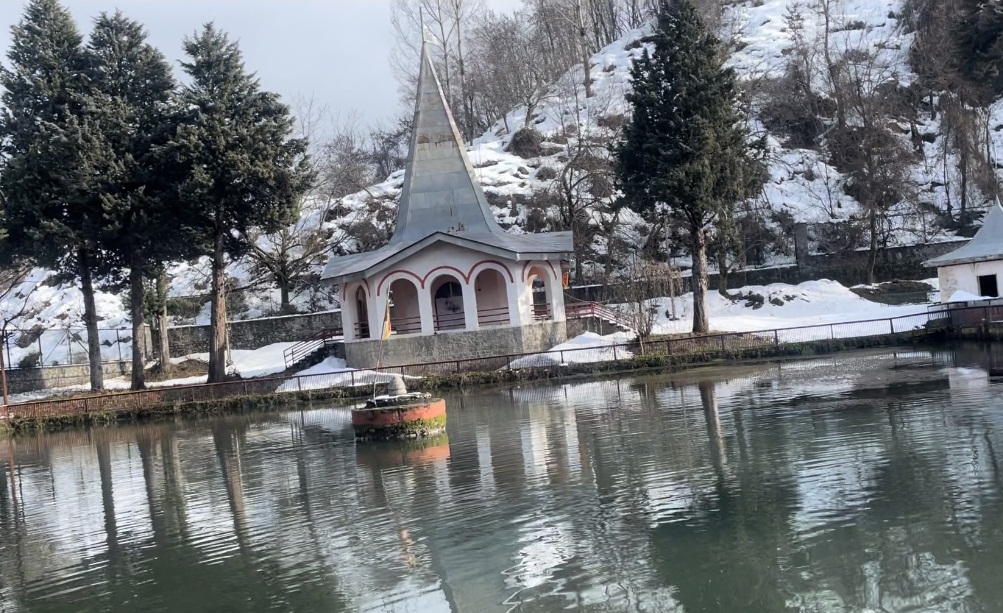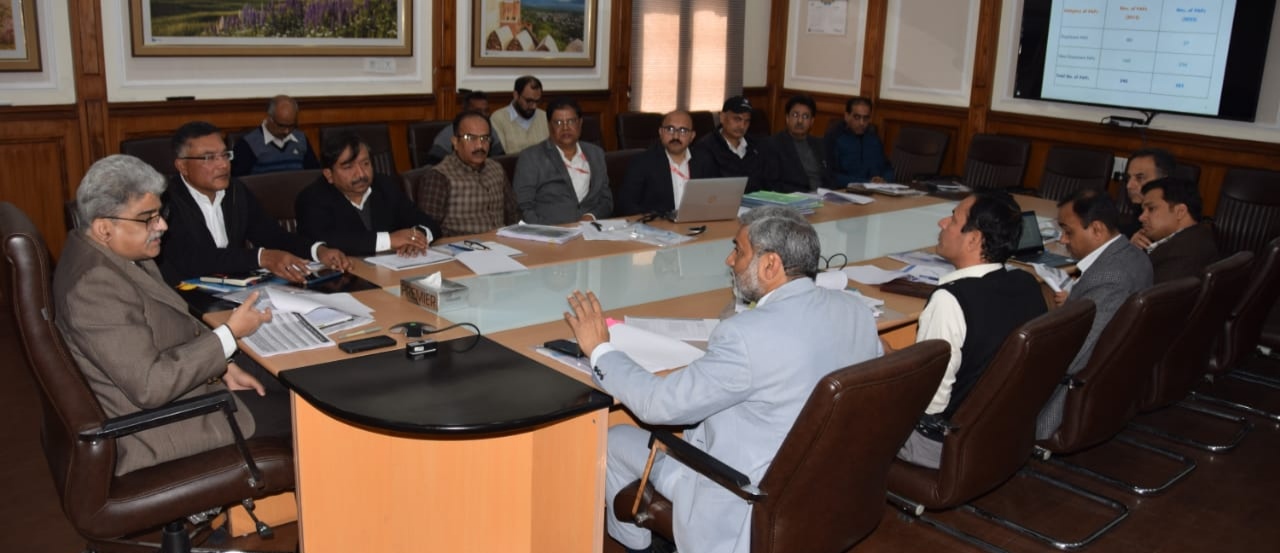Tucked away on the Dooru-Verinag road, the village of Larkipora and its adjacent counterpart, Lokbhawan, unfold a captivating tale of history, spirituality, and enduring legends. This charming village complex, positioned just 8 km south of Anantnag, has recently become my home as I have been posted here for the past two years. Intrigued by its unique dichotomy, where a single revenue village is officially divided into two habitations, Lokbhawan and Larkipora, I embarked on a journey to unravel the mysteries that shroud this quaint corner of Kashmir.
As one traverses the Dooru-Verinag road, Larkipora beckons travelers to explore the enigmatic Lokbhawan, celebrated for its sparkling spring that gracefully descends from a surrounding hill. The Lokbhawan Shrine, affectionately known as the ‘Sedh Laxmi Peeth,’ adds a spiritual touch to the landscape. Perched atop the hill is the sacred Hindu site of ‘Mahakal Barave,’ while to the north of the spring lies ‘Narayan Nag.’ This locale is famed for the ancient pilgrimage known as the Lok Bhawan pilgrimage. Tirth Raj Lok Bhawan stands as one of Kashmir’s ancient pilgrimage centers, formerly known as Lok-Punya and later rechristened as Lok Bhawan. The temple complex, nestled beneath a hill, houses the Mata Sedh Lakshmi temple, Waman Ganga spring, Saraswati Kund, and the shrine of deity Bhariava, showcasing a convergence of divinity and nature. This pilgrimage encompasses a shrine, a small spring at an elevation, and a large spring, the Lok Bhawan Spring, which receives water from the elevated small holy spring situated at the foot of the hillock.
The Lok Bhawan Spring is abundant with water and teems with sacred fish. Flowing like a blanket, the water from this spring transforms into a stream as it exits from the shrine. Devotees engage in ceremonial bathing near this exit. The total land under this shrine spans 20 kanals, hosting two springs across an area of 8 Kanal and 10 Marlas. The larger spring measures 60 feet in length and 54 feet in width, while the smaller spring is 10 feet long and 8 feet in width. Historical records attribute the development of the spring to King Aurangzeb, facilitated by his Subehdar Saif Khan.
Delving into the historical fabric, Lokbhawan’s origin is traced back to the reign of the local ruler ‘Loknatha,’ once referred to as ‘Rudrabhawan’ and ‘Loka-Punya.’ The annals of history, including ‘Kalhana’s Rajtarangni’ and M.A Stein’s translation, highlight Lokbhawan’s prominence and the significance of its Holy Spring. Legends echo the foundation laid by Lalitaditya, marking Lokbhawan as a hub for landlords called ‘Damras’ during the latter years of his rule. ‘Tuzki-Jahangiri’ solidifies its historical imprint, indicating that the village’s inception appears to originate from ‘Sadura’ (currently an independent village) and stretch to ‘Shankarpora’ (now also a separate village).Even now, significant remnants of ancient civilization are unearthed through excavation efforts in both these villages. The region was once densely populated to the extent that a goat managed to ascend a house in the southern end and descend in the northern part of the township. Adjacent to the Holy Spring’s upper side stand the remains of an ancient monument, featuring a cave beneath it. This cave, now nearly sealed due to sediment and mud from the higher areas, reveals depictions of Gods and Goddesses, indicating that it might have served as a sacred worship place for ancient kings.
A Legendary Tale
The village’s historical narrative takes us to the reign of Lalitaditya (7th-8th Century). Legend has it that a humble, dumb Hindu woman named ‘Dayamal’ resided in Lokbhawan, earning her livelihood by delivering water to households. Facing a scarcity of drinking water, Dayamal’s devotion to duty was put to the test during heavy snowfall.
Encountering a ferocious lion on her path, Dayamal fearlessly pleaded to fulfill her promise to a deserving family. Miraculously, the lion closed its mouth and vanished into the darkness. A celestial voice then guided Dayamal to a specific location where a group of crows, led by a white one, would unearth a spring, relieving the township of its water woes. Some believe that on that transformative day, Dayamal turned into a crow and soared with them.
Renowned saints like Sheikh Noor-Ud-Din Wali and Swami Merzakak immortalize ‘Dayamal’ in verses, capturing the essence of her selfless service and spiritual journey. These poetic tributes amplify the cultural significance of Lokbhawan and its revered inhabitants. The name is commemorated in the well known shrukh of Sheikh Noor-ul-Din Noorani.
Lokabhawana ‘na’ chi kaji
A kaji karan Siva
Saati jahnavaran tsaji
Tin var ditam deva
(Hail to the mute lade of Lok Bhawan, with dedication one and all she served, away she departed with the birds, Grant me, Lord, a boon as that.)
Harbah Festival
The annual Har Bhah pilgrimage, celebrated with fervour and devotion, holds special significance for women who partake in a ritualistic bath in the twelve springs, seeking redemption from sins. The festival’s connection to the afterlife, where women are questioned about their participation in the pilgrimage, adds a spiritual dimension to Lok Bhawan’s cultural fabric. Harbah, observed on Ashad Shakulpaksh Duadashi, becomes a testament to the enduring faith in Lokbhawan.
Despite facing adversity, the Lokbhawan Shrine bore witness to destruction in February 1986, only to rise again through the reconstruction efforts led by the then Governor of Jammu and Kashmir, Jagmohan. The shrine’s resilience in the face of challenges speaks volumes about its cultural and religious importance.S.N Veer has written a lot about the shrine and its history. It was by virtue of his efforts and saint PushkaraSwami that the shrine came to the centre stage age.
Beyond the historical prominence of Lokbhawan, the village itself is a living heritage. It serves as a link between the past and the present, connecting locals with their ancestral roots. Lok Bhawan, once a flourishing town, has weathered the passage of time, undergoing transformations under the rule of local rulers and royal patronage. Today, the remnants of its illustrious past are visible in the ruins of old buildings and archaeological excavations, reminding visitors of the area’s former glory.
The mass exodus of Kashmiri Pandits in 1992 marked a challenging period for Lok Bhawan Shrine. Despite being in exile, the Prabandhak Committee continued its efforts to preserve the shrine’s legacy. Today, the shrine exists in two branches—one in Jammu and another in New Delhi—keeping the flame of devotion alive in the hearts of those who had to leave their ancestral land.
(Author is a regular columnist and can be reached on: [email protected])








